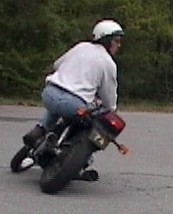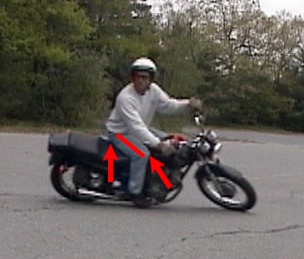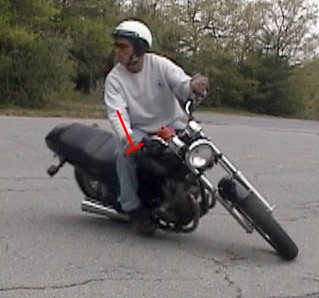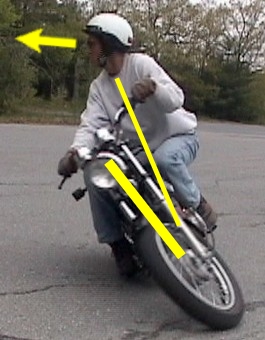|
|
|
Thinking Outside of the Box...
Many riders seem to struggle with the Counterweight technique, which
is a really convenient skill to have, but isn't going to be useful in avoiding
high-speed crashes. It's a low-speed, tight turn technique. Here are my thoughts:
 | 1.
The technique begins here. By shifting the weight to the outside and maintaining
enough speed, the motorcycle
feels more stable, yet leans farther into the turn than it would without
shifting the weight. The increased lean angle allows the bike to turn a
tighter radius.More lean = tighter turn.
Feel how much of your weight is pressing on the outside footpeg; the more pressure
you generate there, the better. If the handlebars are turned too far and come against
the stop, an option for fine control is lost. Avoid turning the bars full
lock. |
|
|
|
|
|  2.
By moving fully across the seat toward the outside, the knee of the inner
leg is drawn up against the tank and saddle, preventing undesirable "body
language", where the less proficient rider misguidedly swings the inner
knee out into the air, decreasing the rider's contact with the bike, and
depriving oneself of an important point of leverage for working the handlebars
and hand controls. Such a mistake also has the effect of moving weight
inwards, which undermines the objective of keeping the rider's weight toward
the outside. 2.
By moving fully across the seat toward the outside, the knee of the inner
leg is drawn up against the tank and saddle, preventing undesirable "body
language", where the less proficient rider misguidedly swings the inner
knee out into the air, decreasing the rider's contact with the bike, and
depriving oneself of an important point of leverage for working the handlebars
and hand controls. Such a mistake also has the effect of moving weight
inwards, which undermines the objective of keeping the rider's weight toward
the outside. |
 | 3.
There is an added benefit to this technique: the right forearm remains square with the throttle,
an ideal position for making the small adjustments in power that are essential for maintaining precise control.
Some coaches suggest using the clutch to control power smoothly, which works well the
rider maintains continuous application of power to stabilize the bike while they are turning.
New riders may have difficulty doing this on top of everything else, and frequently end up keeping the
clutch squeezed for too long, depriving themselves of power for stability just when they need it most.
I prefer to stay fully engaged with 2nd gear and focus on better control of lean angle and working the throttle
smoothly instead. Some riders will find it easier to work with first gear if they feel very comfortable with using the clutch.
In any case, you should use the gear that works best for you.
|
|
 4.
And as you see throughout all of these pictures, the head and eyes are
pointed well ahead into the intended direction of the turn, leading you
to your destination.
Your bike will go where you are looking. 4.
And as you see throughout all of these pictures, the head and eyes are
pointed well ahead into the intended direction of the turn, leading you
to your destination.
Your bike will go where you are looking.
Keep the eyes up.
This frame also clearly shows the differences of lean
angle between the rider's upper body and the bike. As you work at this skill, remember you will need time and
repetitions to make progress. Your turns might not fit inside the box at first, but be patient and remember
to turn your head.
|
|
 2.
By moving fully across the seat toward the outside, the knee of the inner
leg is drawn up against the tank and saddle, preventing undesirable "body
language", where the less proficient rider misguidedly swings the inner
knee out into the air, decreasing the rider's contact with the bike, and
depriving oneself of an important point of leverage for working the handlebars
and hand controls. Such a mistake also has the effect of moving weight
inwards, which undermines the objective of keeping the rider's weight toward
the outside.
2.
By moving fully across the seat toward the outside, the knee of the inner
leg is drawn up against the tank and saddle, preventing undesirable "body
language", where the less proficient rider misguidedly swings the inner
knee out into the air, decreasing the rider's contact with the bike, and
depriving oneself of an important point of leverage for working the handlebars
and hand controls. Such a mistake also has the effect of moving weight
inwards, which undermines the objective of keeping the rider's weight toward
the outside. 4.
And as you see throughout all of these pictures, the head and eyes are
pointed well ahead into the intended direction of the turn, leading you
to your destination.
4.
And as you see throughout all of these pictures, the head and eyes are
pointed well ahead into the intended direction of the turn, leading you
to your destination.

